Beautiful Soup
22 Apr 2020
Web Scraping With Python: Beautiful Soup
Learn what web scraping is and how it can be achieved with the help of Python's beautiful soup library. Learn by using Amazon website data.
If you are just getting started in Python and would like to learn more, take DataCamp's Introduction to Data Science in Python course.
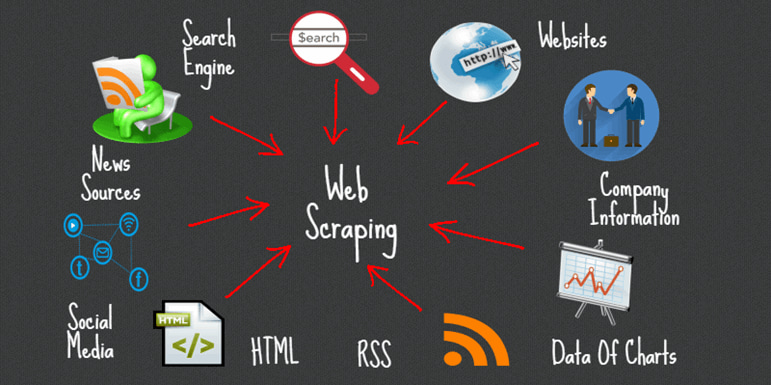
In the time when the internet is rich with so much data, and apparently, data has become the new oil, web scraping has become even more important and practical to use in various applications. Web scraping deals with extracting or scraping the information from the website. Web scraping is also sometimes referred to as web harvesting or web data extraction. Copying text from a website and pasting it to your local system is also web scraping. However, it is a manual task. Generally, web scraping deals with extracting data automatically with the help of web crawlers. Web crawlers are scripts that connect to the world wide web using the HTTP protocol and allows you to fetch data in an automated manner.
Whether you are a data scientist, engineer, or anybody who analyzes vast amounts of datasets, the ability to scrape data from the web is a useful skill to have. Let's say you find data from the web, and there is no direct way to download it, web scraping using Python is a skill you can use to extract the data into a useful form that can then be imported and used in various ways.
Some of the practical applications of web scraping could be:
Gathering resume of candidates with a specific skill,
Extracting tweets from twitter with specific hashtags,
Lead generation in marketing,
Scraping product details and reviews from e-commerce websites.
Apart from the above use-cases, web scraping is widely used in natural language processing for extracting text from the websites for training a deep learning model.
Potential Challenges of Web Scraping
One of the challenges you would come across while scraping information from websites is the various structures of websites. Meaning, the templates of websites will differ and will be unique; hence, generalizing across websites could be a challenge.
Another challenge could be longevity. Since the web developers keep updating their websites, you cannot certainly rely on one scraper for too long. Even though the modifications might be minor, but they still might create a hindrance for you while fetching the data.
Hence, to address the above challenges, there could be various possible solutions. One would be to follow continuous integration & development (CI/CD) and constant maintenance as the website modifications would be dynamic.
Another more realistic approach is to use Application Programming Interfaces (APIs) offered by various websites & platforms. For example, Facebook and twitter provide you API's specially designed for developers who want to experiment with their data or would like extract information to let's say related to all friends & mutual friends and draw a connection graph of it. The format of the data when using APIs is different from usual web scraping i.e., JSON or XML, while in standard web scraping, you mainly deal with data in HTML format.
What is Beautiful Soup?
Beautiful Soup is a pure Python library for extracting structured data from a website. It allows you to parse data from HTML and XML files. It acts as a helper module and interacts with HTML in a similar and better way as to how you would interact with a web page using other available developer tools.
It usually saves programmers hours or days of work since it works with your favorite parsers like
lxmlandhtml5libto provide organic Python ways of navigating, searching, and modifying the parse tree.Another powerful and useful feature of beautiful soup is its intelligence to convert the documents being fetched to Unicode and outgoing documents to UTF-8. As a developer, you do not have to take care of that unless the document intrinsic doesn't specify an encoding or Beautiful Soup is unable to detect one.
It is also considered to be faster when compared to other general parsing or scraping techniques.
Types of Parsers
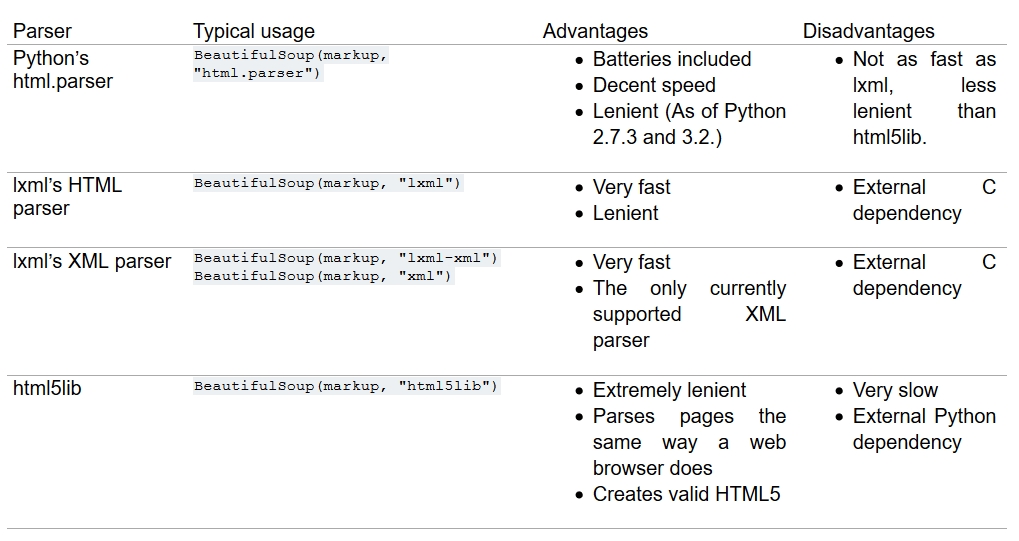
Feel free to read more about it from here.
Enough of theory, right? So, let's install beautiful soup and start learning about its features and capabilities using Python.
As a first step, you need to install the Beautiful Soup library using your terminal or jupyter lab. The best way to install beautiful soup is via pip, so make sure you have the pip module already installed.
Importing necessary libraries
Let's import the required packages which you will use to scrape the data from the website and visualize it with the help of seaborn, matplotlib, and bokeh.
Scraping the Amazon Best Selling Books
This URL that you are going to scrape is the following: https://www.amazon.in/gp/bestsellers/books/ref=zg_bs_pg_'+str(pageNo)+'?ie=UTF8&pg='+str(pageNo) (If you can't access this link, here is the parent link). As you can see, the page argument can be modified to access data for each page. Hence, to access all the pages you will need to loop through all the pages to get the necessary dataset, but first, you need to find out the number of pages from the website.
To connect to the URL and fetch the HTML content following things are required:
Define a
get_datafunction which will input the page numbers as an argument,Define a
user-agentwhich will help in bypassing the detection as a scraper,Specify the URL to
requests.getand pass the user-agent header as an argument,Extract the content from requests.get,
Scrape the specified page and assign it to soup variable,
Next and the important step is to identify the parent tag under which all the data you need will reside. The data that you are going to extract is:
Book Name
Author
Rating
Customers Rated
Price
The below image shows where the parent tag is located, and when you hover over it, all the required elements are highlighted.
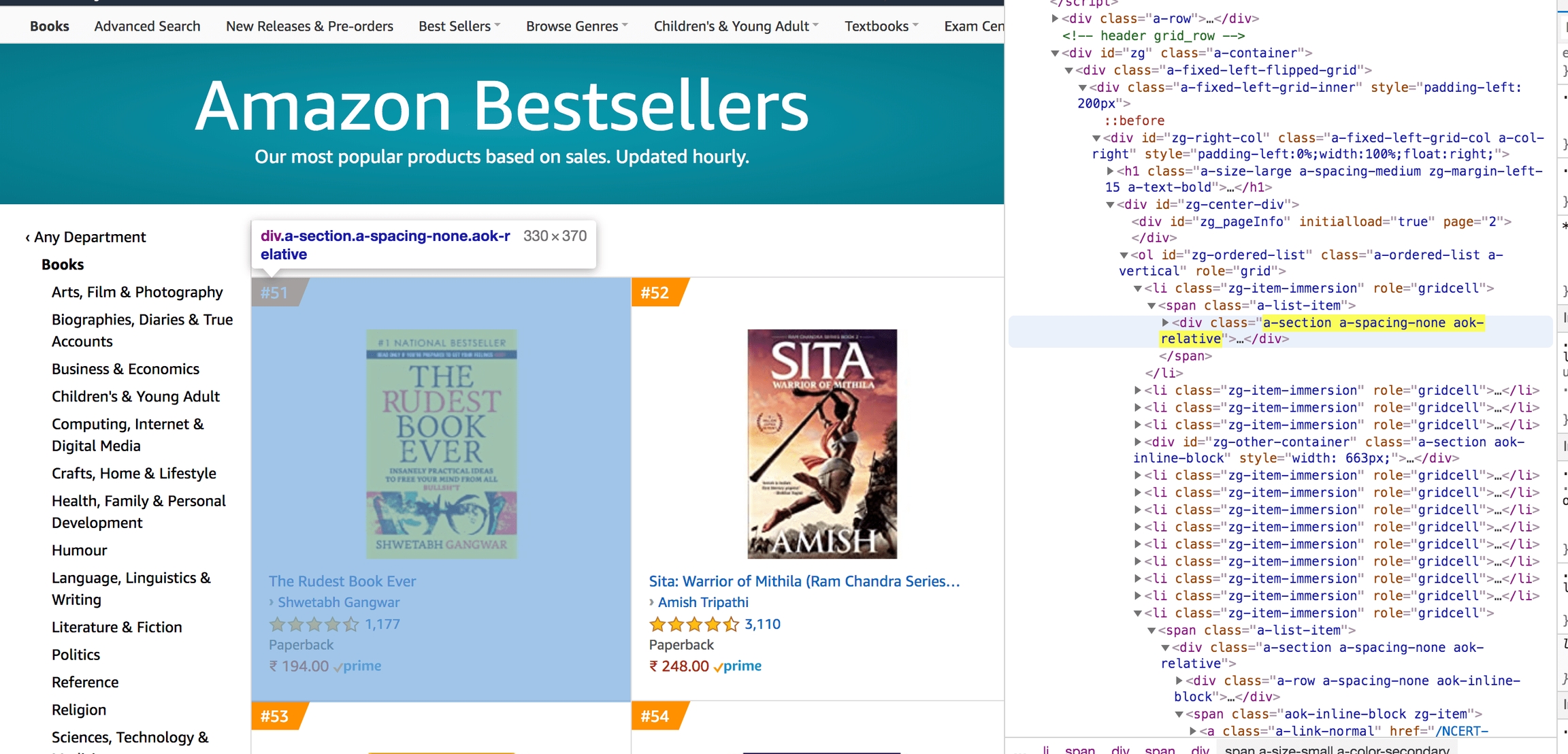
Similar to the parent tag, you need to find the attributes for book name, author, rating, customers rated, and price. You will have to go to the webpage you would like to scrape, select the attribute and right-click on it, and select inspect element. This will help you in finding out the specific information fields you need an extract from the sheer HTML web page, as shown in the figure below:
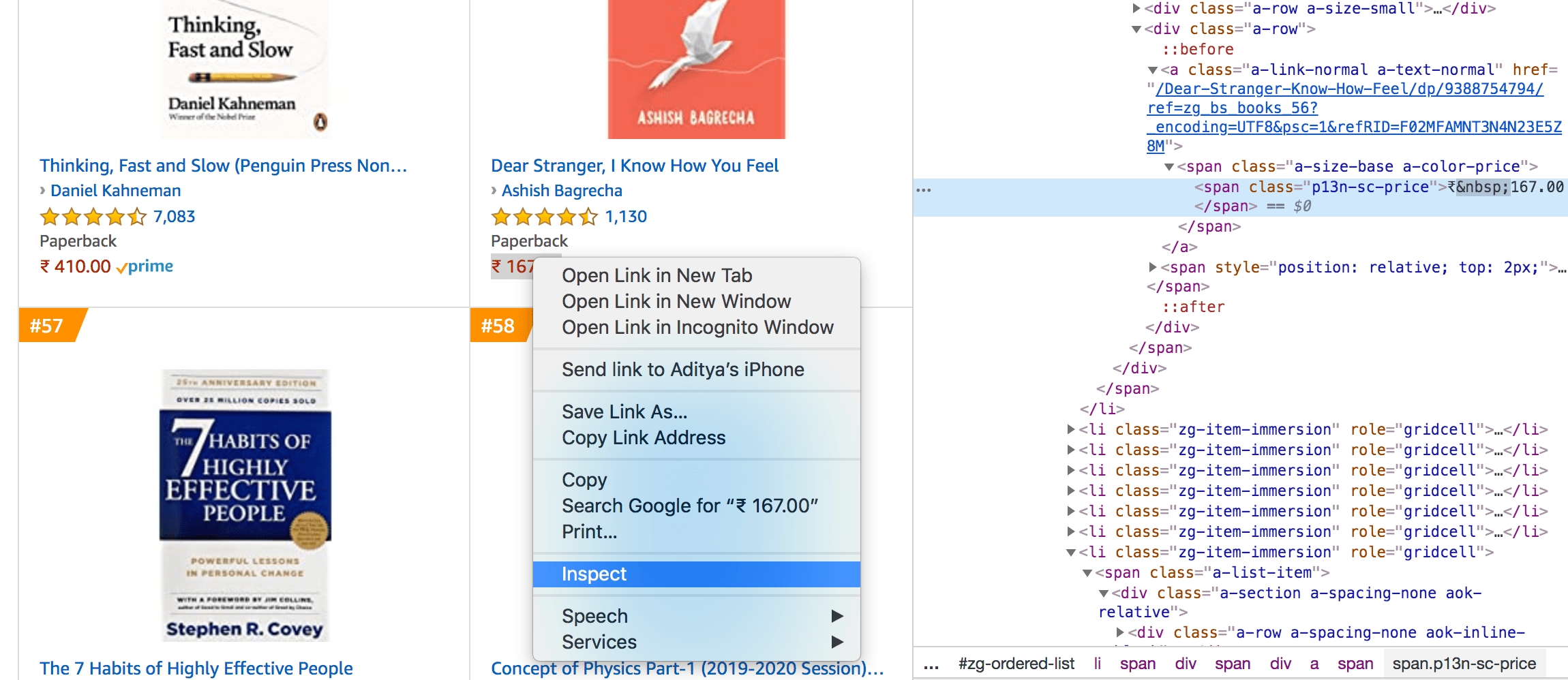
Note that some author names are not registered with Amazon, so you need to apply extra find for those authors. In the below cell code, you would find nested if-else conditions for author names, which are to extract the author/publication names.
The below code cell will perform the following functions:
Call the
get_datafunction inside a for loop,The
forloop will iterate over this function starting from 1 till the number of pages+1.Since the output will be a nested list, you would first flatten the list and then pass it to the DataFrame.
Finally, save the dataframe as a CSV file.
Reading CSV File
Now let's load the CSV file you created and save in the above cell. Again, this is an optional step; you could even use the dataframe df directly and ignore the below step.
The shape of the dataframe reveals that there are 100 rows and 5 columns in your CSV file.
Let's print the first 5 rows of the dataset.
Book Name
Author
Rating
Customers_Rated
Price
0
The Power of your Subconscious Mind
Joseph Murphy
4.5 out of 5 stars
13,948
₹ 99.00
1
Think and Grow Rich
Napoleon Hill
4.5 out of 5 stars
16,670
₹ 99.00
2
Word Power Made Easy
Norman Lewis
4.4 out of 5 stars
10,708
₹ 130.00
3
Mathematics for Class 12 (Set of 2 Vol.) Exami...
R.D. Sharma
4.5 out of 5 stars
18
₹ 930.00
4
The Girl in Room 105
Chetan Bhagat
4.3 out of 5 stars
5,162
₹ 149.00
...
...
...
...
...
...
56
COMBO PACK OF Guide To JAIIB Legal Aspects Pri...
MEC MILLAN
4.5 out of 5 stars
114
₹ 1,400.00
57
Wren & Martin High School English Grammar and ...
Rao N
4.4 out of 5 stars
1,613
₹ 400.00
58
Objective General Knowledge
Sanjiv Kumar
4.2 out of 5 stars
742
₹ 254.00
59
The Rudest Book Ever
Shwetabh Gangwar
4.6 out of 5 stars
1,177
₹ 194.00
60
Sita: Warrior of Mithila (Ram Chandra Series -...
Amish Tripathi
4.4 out of 5 stars
3,110
₹ 248.00
61 rows × 5 columns
Let's do some preprocessing on the ratings, customers_rated, and price column.
Since you know the ratings are out of 5, you can keep only the rating and remove the extra part from it.
From the customers_rated column, remove the comma.
From the price column, remove the rupees symbol, comma, and split it by dot.
Finally, convert all the three columns into integer or float.
Book Name
Author
Rating
Customers_Rated
Price
0
The Power of your Subconscious Mind
Joseph Murphy
4.5
13948
99
1
Think and Grow Rich
Napoleon Hill
4.5
16670
99
2
Word Power Made Easy
Norman Lewis
4.4
10708
130
3
Mathematics for Class 12 (Set of 2 Vol.) Exami...
R.D. Sharma
4.5
18
930
4
The Girl in Room 105
Chetan Bhagat
4.3
5162
149
Let's verify the data types of the DataFrame.
Replace the zero values in the DataFrame to NaN.
Counting the Number of NaNs in the DataFrame
From the above output, you can observe that there is a total of six books that do not have an Author Name, while one book does not have a price associated with it. These pieces of information are crucial for an author who wants to sell his or her books and should not neglect to put such information.
Let's drop these NaNs.
Authors Highest Priced Book
Let's find out which all authors had the highest-priced book. You will visualize the results for such the top 20 authors.
Book Name
Author
Rating
Customers_Rated
Price
56
COMBO PACK OF Guide To JAIIB Legal Aspects Pri...
MEC MILLAN
4.5
114
1400.0
98
Diseases of Ear, Nose and Throat
P L Dhingra
4.7
118
1285.0
3
Mathematics for Class 12 (Set of 2 Vol.) Exami...
R.D. Sharma
4.5
18
930.0
96
Madhymik Bhautik Vigyan -12 (Part 1-2) (NCERT ...
Kumar-Mittal
5.0
1
765.0
6
My First Library: Boxset of 10 Board Books for...
Wonder House Books
4.5
3116
750.0
38
Indian Polity - For Civil Services and Other S...
M. Laxmikanth
4.6
1210
700.0
42
A Modern Approach to Verbal & Non-Verbal Reaso...
R.S. Aggarwal
4.4
1822
675.0
27
The Intelligent Investor (English) Paperback –...
Benjamin Graham
4.4
6201
650.0
99
Law of CONTRACT & Specific Relief
Dr. Avtar Singh
4.4
23
643.0
49
All In One ENGLISH CORE CBSE Class 12 2019-20
Arihant Experts
4.4
493
599.0
72
The Secret
Rhonda Byrne
4.5
11220
556.0
86
How to Prepare for Quantitative Aptitude for t...
Arun Sharma
4.4
847
537.0
8
Quantitative Aptitude for Competitive Examinat...
R S Aggarwal
4.4
4553
435.0
16
Sapiens: A Brief History of Humankind
Yuval Noah Harari
4.6
14985
434.0
84
Concept of Physics Part-2 (2019-2020 Session) ...
H.C. Verma
4.6
1807
433.0
Loading BokehJS ...
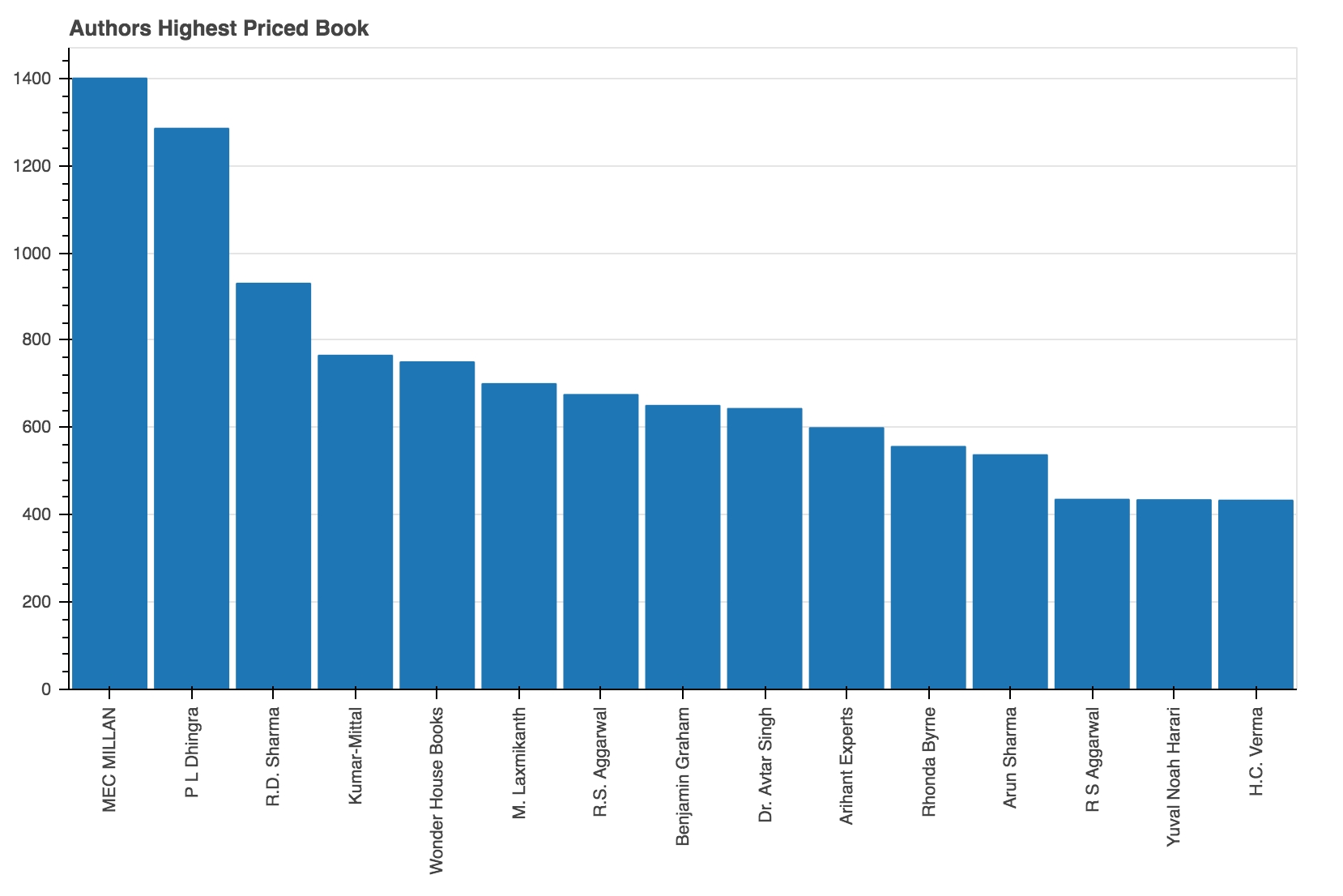
From the above graph, you can observe that the top two highest-priced books are by the author Mecmillan and P L Dhingra.
Top Rated Books and Authors wrt Customers Rated
Let's find out which authors have the top-rated books and which books of those authors are top rated. However, while finding this out, you would filter out those authors in which less than 1000 customers rated.
Book Name
Author
Rating
Customers_Rated
Price
26
Inner Engineering: A Yogi’s Guide to Joy
Sadhguru
4.7
4091
254.0
70
Bhagavad-Gita (Hindi)
A. C. Bhaktivedanta
4.7
1023
150.0
11
The Alchemist
Paulo Coelho
4.7
22182
264.0
47
Harry Potter and the Philosopher's Stone
J.K. Rowling
4.7
7737
234.0
84
Concept of Physics Part-2 (2019-2020 Session) ...
H.C. Verma
4.6
1807
433.0
16
Sapiens: A Brief History of Humankind
Yuval Noah Harari
4.6
14985
434.0
38
Indian Polity - For Civil Services and Other S...
M. Laxmikanth
4.6
1210
700.0
29
Wings of Fire: An Autobiography of Abdul Kalam
Arun Tiwari
4.6
3513
301.0
39
The Theory of Everything
Stephen Hawking
4.6
2004
199.0
25
The Immortals of Meluha (Shiva Trilogy)
Amish
4.6
4538
248.0
23
Life's Amazing Secrets: How to Find Balance an...
Gaur Gopal Das
4.6
3422
213.0
34
Dear Stranger, I Know How You Feel
Ashish Bagrecha
4.6
1130
167.0
17
The Monk Who Sold His Ferrari
Robin Sharma
4.6
5877
137.0
13
How to Win Friends and Influence People
Dale Carnegie
4.6
15377
99.0
59
The Rudest Book Ever
Shwetabh Gangwar
4.6
1177
194.0
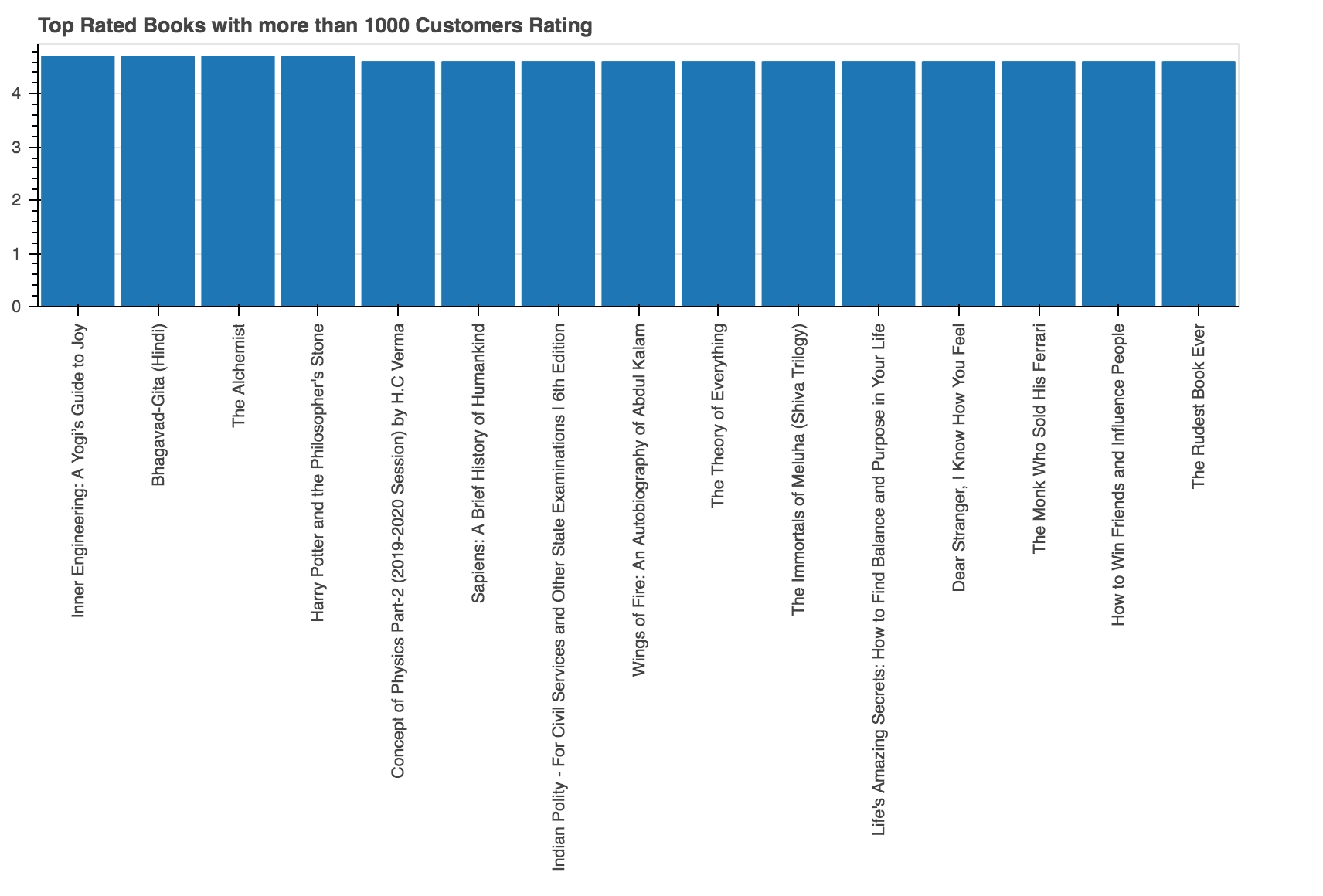
From the above output, you can observe that the top three rated books with more than 1000 customer ratings are Inner Engineering: A Yogi’s Guide to Joy, Bhagavad-Gita (Hindi), and The Alchemist.
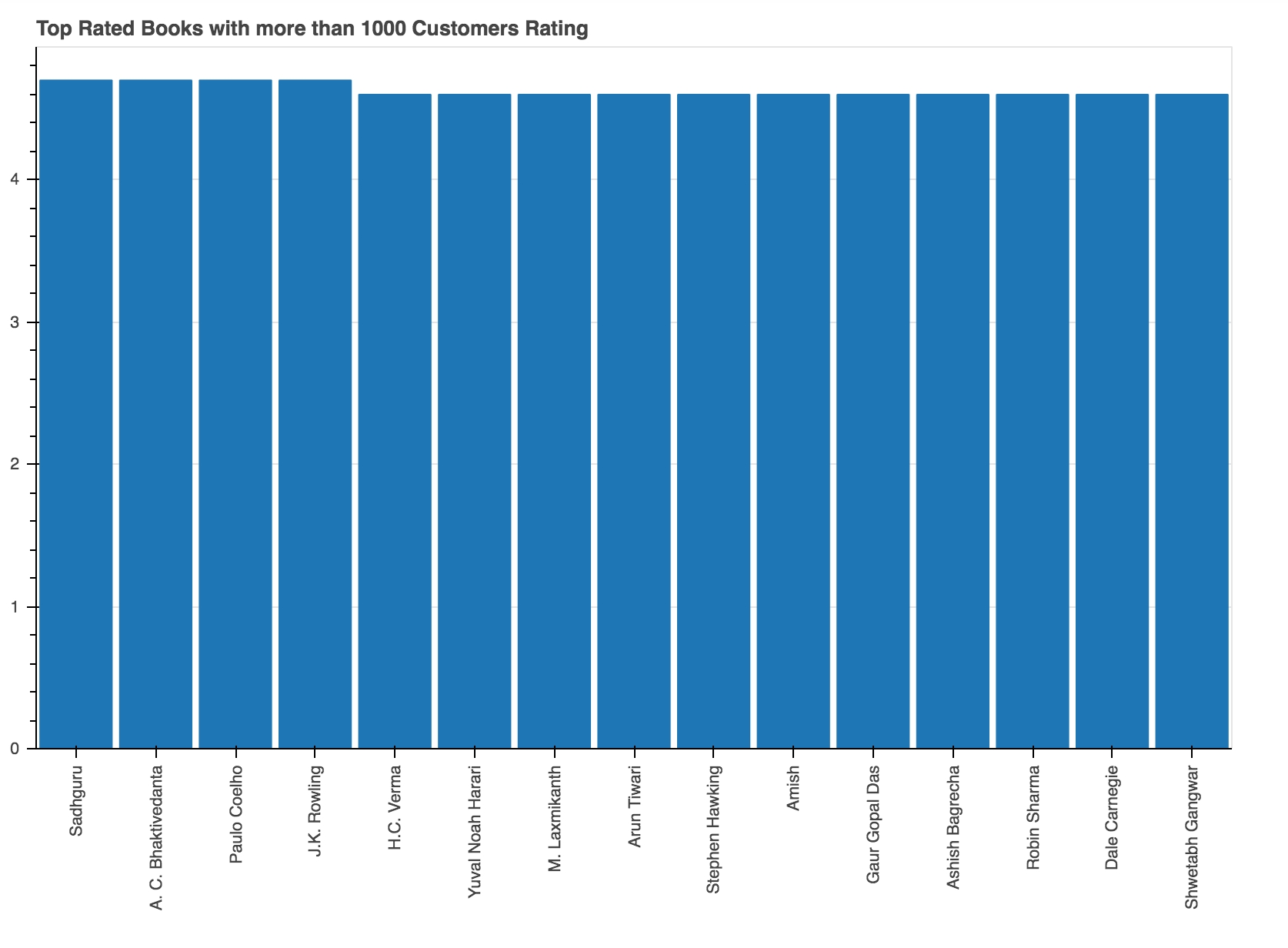
The above graph shows the top 10 authors in descending order who have the highest rated books with more than 1000 customer ratings, which are Sadhguru, A. C. Bhaktivedanta and Paulo Coelho.
Most Customer Rated Authors and Books
While you have already seen the top-rated books and top-rated authors, it would still be more convincing and credible to conclude the best author and the book based on the number of customers who rated for that book.
So, let's quickly find that out.
Book Name
Author
Rating
Customers_Rated
Price
11
The Alchemist
Paulo Coelho
4.7
22182
264.0
1
Think and Grow Rich
Napoleon Hill
4.5
16670
99.0
13
How to Win Friends and Influence People
Dale Carnegie
4.6
15377
99.0
16
Sapiens: A Brief History of Humankind
Yuval Noah Harari
4.6
14985
434.0
18
Rich Dad Poor Dad : What The Rich Teach Their ...
Robert T. Kiyosaki
4.5
14591
296.0
10
The Subtle Art of Not Giving a F*ck
Mark Manson
4.4
14418
365.0
0
The Power of your Subconscious Mind
Joseph Murphy
4.5
13948
99.0
48
The Power of Your Subconscious Mind
Joseph Murphy
4.5
13948
99.0
72
The Secret
Rhonda Byrne
4.5
11220
556.0
41
1984
George Orwell
4.5
10829
95.0
2
Word Power Made Easy
Norman Lewis
4.4
10708
130.0
46
Man's Search For Meaning: The classic tribute ...
Viktor E Frankl
4.4
8544
245.0
67
The 7 Habits of Highly Effective People
R. Stephen Covey
4.3
8229
397.0
47
Harry Potter and the Philosopher's Stone
J.K. Rowling
4.7
7737
234.0
40
One Indian Girl
Chetan Bhagat
3.8
7128
113.0
65
Thinking, Fast and Slow (Penguin Press Non-Fic...
Daniel Kahneman
4.4
7087
410.0
27
The Intelligent Investor (English) Paperback –...
Benjamin Graham
4.4
6201
650.0
17
The Monk Who Sold His Ferrari
Robin Sharma
4.6
5877
137.0
53
Ram - Scion of Ikshvaku (Ram Chandra)
Amish Tripathi
4.2
5766
262.0
93
The Richest Man in Babylon
George S. Clason
4.5
5694
129.0
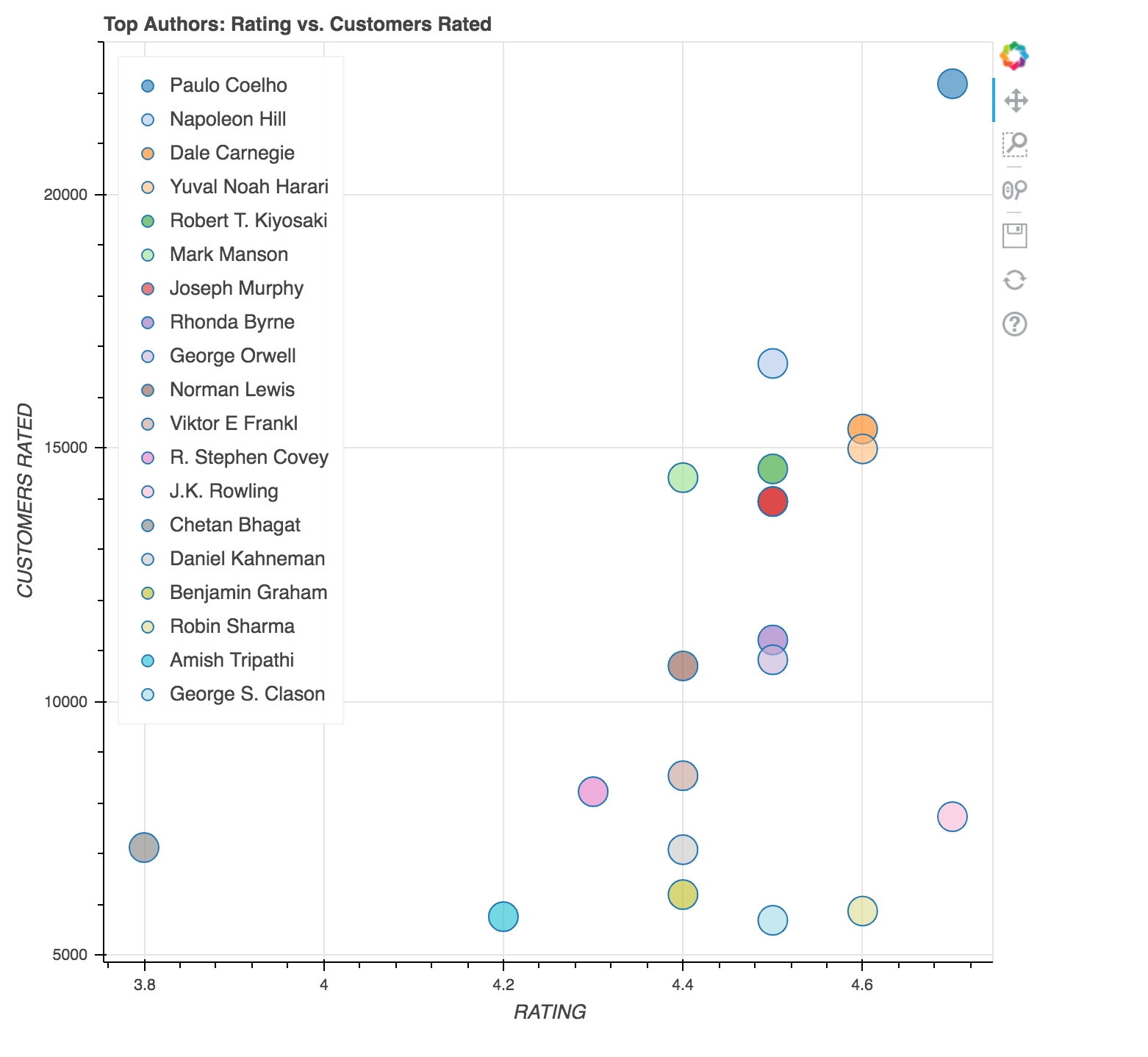
The above graph is a scatter plot of Authors who bagged customer rating vs. actual rating. The following conclusions can be made after looking at the above plot.
Hands down Paulo Coelho's book The Alchemist is the best selling book since the rating, and the number of customers rated are both in sync.
The author Amish Tripathi's book Ram - Scion of Ikshvaku (Ram Chandra) has a rating of 4.2 with a 5766 customer rating. However, the author George S. Clason's book The Richest Man in Babylon has almost similar customers rating, but the overall rating is 4.5. Hence, it can be concluded that more customers gave a high rating to The Richest Man in Babylon.
Conclusion
Congratulations on finishing the tutorial.
This tutorial was a basic introduction to web scraping with beautiful soup and how you can make sense out of the information extracted from the web by visualizing it using the bokeh plotting library. A good exercise to take a step forward in learning web scraping with beautiful soup is to scrape data from some other websites and see how you can get insights from it.
If you are just getting started in Python and would like to learn more, take DataCamp's Introduction to Data Science in Python course.
Reference : https://www.datacamp.com/community/tutorials/amazon-web-scraping-using-beautifulsoup
Last updated
Was this helpful?